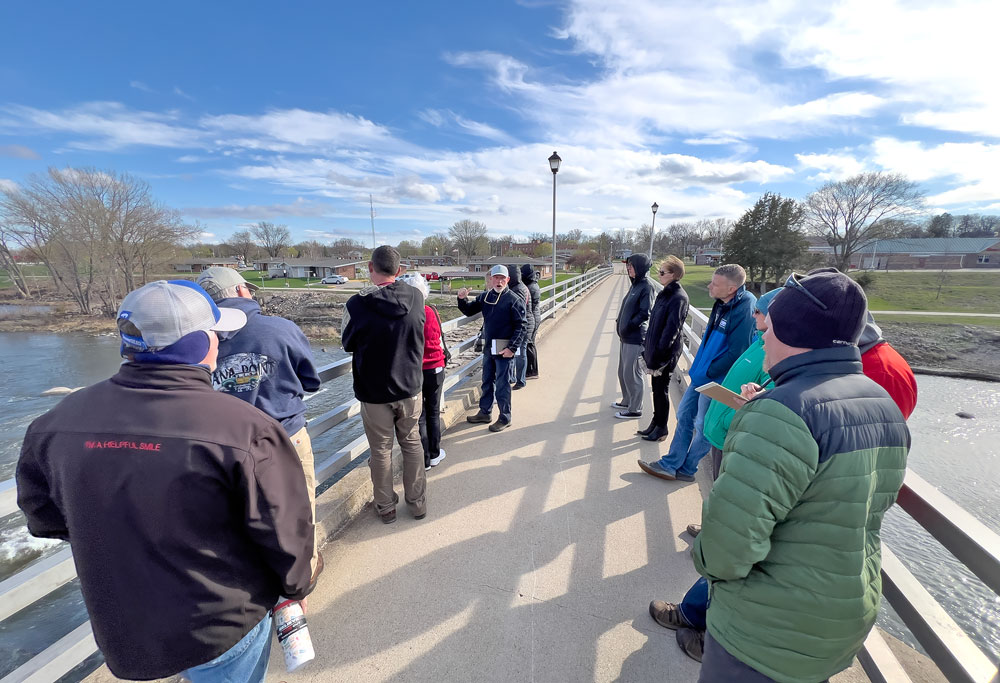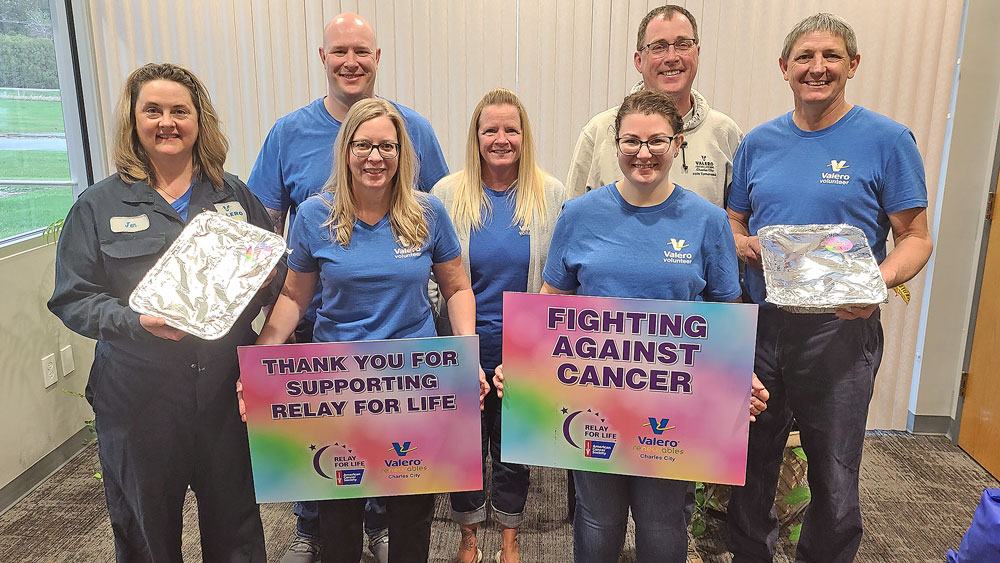Navigator CO2 pipeline group gives update at Floyd County supervisors meeting
By Bob Steenson, bsteenson@charlescitypress.com
Representatives of one of the two carbon dioxide pipelines planning to build through Floyd County were at the county Board of Supervisors meeting this week, offering an update on the company’s plans and answering questions.
Elizabeth Burns-Thomas, the vice president for government and public affairs for Navigator CO2 Ventures, said the company would begin negotiating for right of way easements this month.
“That’s when we’ll start having those conversations with landowners and they’ll see a copy of our easement agreement, as well as that initial dollars and cents associated with compensation,” she said.
“What we think folks will see is that a lot of the things that they asked for as part of those county meetings are represented in those documents,” she said, referring to the public informational meetings the company was required to hold in each county the pipeline is proposed to pass through.
For example, she said, farmers said that three years coverage of potential crop damage because of pipeline construction was not enough, and the amount being offered to cover damage was insufficient.
“We went back and reworked that, increased that percentage and did that math over five years instead,” Burns-Thomas said.
They also heard that landowners wanted options in easement payments, she said.
“For example, we heard from landowners and farmers especially that while some like a lump sum payment, some would prefer to have that spread out over time with an escalator. We provided that as an option,” she said.
Chris Brown, vice president of capital projects for Navigator, said he is overseeing project management and engineering on the project, and provided some updates on the pipeline planned to go through Floyd County.
“The pipeline that goes through this county is an 8-inch-diameter pipeline. The maximum operating pressure it is designed for is 2,200 PSI (pounds per square inch). It will typically operate between 1,300 and 2,100 PSI,” he said.
Brown referred to a carbon dioxide pipeline rupture in Sartartia, Mississippi, that caused several residents to become ill, that is frequently referred to by opponents of the proposed pipelines as an example of what could happen.
“In 2020, In Mississippi, a pipeline operator had a CO2 pipeline that experienced a failure. In doing so, it released CO2 to the atmosphere. It ended up migrating approximately one mile down to the city of Sartartia, Mississippi, and what ended up happening there was they had several residentes that fell ill,” he said.
“They got headaches, they got stomach aches and nausea. A couple were hospitalized. There were no fatalities,” Brown said.
He said the federal Pipeline and Hazardous Materials Safety Administration (PHMSA) issued its final report on that incident just a few months ago, in May, and said the rupture was caused by a landslide, that was triggered by prolonged rain in the area.
Brown said PHMSA found that the pipeline company had failed to do a geohazard analysis on the entire route of its pipeline, and had failed to engage with area emergency management and response departments.
“They didn’t participate in annual drills. They didn’t notify them of what to in the event of an emergency. They had no interactions with that city at all. The city didn’t even know that there was a CO2 pipeline in that area,” he said.
“Where Navigator takes this from there is that we are reaching out and engaging each and every county that we traverse and their emergency management personnel, and also the abutting counties that may or may not have a mutual aid agreement in place,” he said.
In additional to providing training on how to respond to a CO2 release, Navigator will identify any gaps in needed equipment and work to fill those gaps, he said.
He also said Navigator was engaging with several engineering firms to do a complete geohazard analysis of the 1,300-mile proposed route of the Heartland Greenway pipeline, as well as having two plume studies done to show how a CO2 leak might spread.
Based on those reports, Navigator will identify areas that are at a higher level of risk, and then plan to mitigate that risk. That could mean using thicker-walled pipe in that area or installing more valves to be able to better isolate any rupture.
It could also mean using horizontal directional drilling to install the pipe in that area, which would place the pipe 35 to 50 feet below ground.
“We’re weighing and taking all of these into effect, overlaying them onto our proposed centerline right now, and we’ll be able to evaluate each risk and mitigate it accordingly,” Brown said.
As part of state requirements for hazardous material pipeline installation, each county the pipeline passes through will need to designate an inspector to make sure land where construction takes place is returned to its original condition. The cost of the inspector is reimbursed to the counties by the pipeline company.
Supervisor Doug Kamm noted that Floyd County is one of the few counties where both the Navigator pipeline and the other pipeline, proposed by Summit Carbon Solutions, would pass through, and wondered if the same inspector could be used for both.
Monica Howard, Navigator’s senior director of environmental and regulatory, said the current timeline is for Summit to begin construction in 2023 and Navigator to begin in 2024.
If both projects aren’t being done at the same time, then one inspector could do both projects. In fact, she said, that would be a good idea because the inspector could use the lessons learned on the first project to provide guidance on the second.
County Auditor Gloria Carr asked how Navigator would cross county drainage districts.
Howard said most of those crossings will be bored, going in about five feet below any tiles or drainage pipelines.
“We try to make at least a two-foot separation between any existing utilities – fiber, potable water, sewers,” Howard said.
Chad Buffington, plant manager at the Valero ethanol plant near Charles City, said the project is definitely important to Valero, as they are getting challenged every day to reduce their carbon footprint.
“We see partnering with Navigator is going to be the biggest contributor of that for us,” he said. “We’re going to do our part to be good stewards of the environment.”
George Cummins, a landowner and retired ISU Extension crop specialist who has been a steady opponent of the pipeline proposals, said that originally the Poet ethanol plants had said they could handle their carbon dioxide emissions with alternate uses for the CO2, such as for carbonated beverages, dry ice, putting it in concrete – “there’s a whole series of things they were going to do.”
But then, recently, Poet announced that its plants would be a part of the Navigator system.
Cummins asked if the ways to deal with CO2 that Poet had originally proposed could be used to avoid building any pipelines.
Burns-Thomas said even CO2 producers that have alternate ways to use or get rid of their CO2 need a way to transport it.
“Where a Poet, where a Valero, where anybody on the line wants to send their CO2 is up to them. We’re building out that infrastructure so that they can get from Point A to Point B safely and efficiently,” Burns-Thomas said.
Howard said that the company is planning on sequestering 10 million metric tons of CO2 per year underground in Illinois. The marketplace for other uses of CO2 is a small fraction of that amount, she said.
“Absolutely there’s a lot more research going on and people are finding very inventive and great ways to sequester CO2 that’s not underground, but that still won’t meet the full demand of the volume available at these facilities,” she said.
Cummins asked about the use of CO2 injection into oil wells to increase the amount of oil that can be extracted.
Howard said there’s no enhanced oil recovery – EOR – going on in the area where they plan to sequester CO2 underground in Illinois.
Burns-Thomas said, “What’s present in the region that we’re going into is one of the few places where ethanol is doing this right now. ADM has had an operating site doing carbon capture at their Decatur ethanol plant for just about the better part of a decade, and sequestering it underground.”
Responding to a question of how far from residences the pipeline has to be, Howard said the rule is generally 50 feet for a liquid pipeline, but Navigator is going far beyond that.
“The plume modeling that we’re undertaking will necessitate hundreds if not a thousand or more feet, depending on the size of the line and all that,” she said. “Our target setback is 420 feet in Floyd County, based on the size of the line.”
The Iowa Utilities Board this week approved additional county informational meetings regarding the Navigator pipeline in 12 counties, because of changes in the proposed route of the pipeline.
Floyd County is not among the counties where an additional meeting is required, but Butler and Bremer are.
The proposed route changed with the recent announcement that POET will collect CO2 from 18 plants in Iowa, Nebraska and South Dakota as part of the Navigator project.
ADM also announced recently that it would partner with a with a different company to build a separate pipeline to connect with ADM plants in Clinton and Cedar Rapids, thereby dropping Linn county from the Navigator route.








Social Share